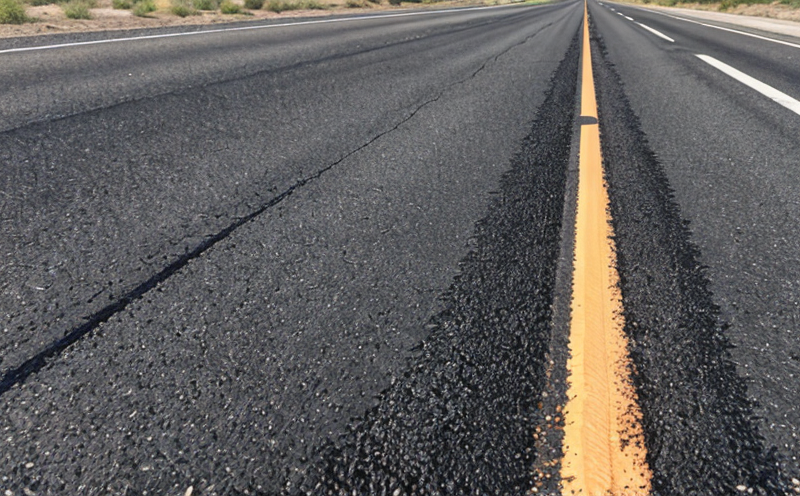ISO 13473 Pavement Macrotexture Analysis
The ISO 13473 standard provides a comprehensive framework for measuring the macrotexture of pavements. This parameter is crucial in ensuring road safety, durability, and compliance with international standards. The macrotexture of pavement surfaces influences both vehicle-tire interaction and pedestrian slip resistance. Understanding these characteristics helps maintain safe driving conditions and reduce accidents.
The ISO 13473 method utilizes a texture board to assess the roughness of the pavement surface. The texture board is placed on the road, and the macrotexture is measured using various instruments that comply with this international standard. The measurement process involves scanning the texture board at specific intervals and analyzing the data obtained.
The significance of ISO 13473 lies in its applicability across different types of pavements, from urban roads to rural highways. It ensures consistent testing methods worldwide, which is essential for comparing results internationally. This standard helps quality managers, compliance officers, R&D engineers, and procurement teams ensure their projects meet international safety standards.
The pavement macrotexture test involves several steps: surface preparation, calibration of instruments, data acquisition, and analysis. Proper surface preparation ensures accurate measurements by eliminating external factors that could affect the results. Calibration of instruments guarantees consistent and reliable readings across multiple tests. Data acquisition is performed using high-precision equipment designed to meet ISO 13473 specifications.
Understanding the macrotexture of pavement surfaces allows for informed decision-making in road construction, maintenance, and safety improvements. By adhering to this standard, stakeholders can ensure their projects comply with international best practices. The test results provide valuable insights into the condition of pavements, helping identify areas needing attention or improvement.
The ISO 13473 method is particularly useful for assessing the macrotexture of asphalt and concrete surfaces. These materials are widely used in road construction due to their durability and ability to withstand heavy traffic loads. By measuring the macrotexture of these surfaces, stakeholders can ensure that they meet the required standards for safety and performance.
The test results can be used to assess various aspects of pavement quality, including slip resistance, skid resistance, and overall surface condition. These factors are critical in ensuring safe driving conditions and reducing accidents on roads. By using ISO 13473, stakeholders can ensure that their projects comply with international best practices for road safety and durability.
The test results provide valuable insights into the condition of pavements, helping identify areas needing attention or improvement. This information is essential for quality managers, compliance officers, R&D engineers, and procurement teams to make informed decisions about road construction, maintenance, and safety improvements.
Scope and Methodology
| Parameter | Description |
|---|---|
| Pavement Type | Asphalt and concrete surfaces are commonly tested. |
| Measurement Tool | ISO-compliant texture board is used for accurate measurements. |
| Data Acquisition | High-precision instruments scan the texture board at specified intervals. |
| Data Analysis | The collected data is analyzed to determine macrotexture levels. |
| Safety Factors | Results are used to assess slip and skid resistance on roads. |
| Compliance | Results ensure compliance with international standards for road safety. |
The ISO 13473 standard provides a comprehensive framework for measuring the macrotexture of pavements. This parameter is crucial in ensuring road safety, durability, and compliance with international standards. The macrotexture of pavement surfaces influences both vehicle-tire interaction and pedestrian slip resistance.
The measurement process involves scanning the texture board at specific intervals using high-precision instruments designed to meet ISO 13473 specifications. This ensures accurate and reliable results, which are essential for assessing various aspects of pavement quality, including slip resistance, skid resistance, and overall surface condition.
Benefits
The benefits of using the ISO 13473 standard for pavement macrotexture analysis extend beyond simple compliance with international standards. By adhering to this method, stakeholders can ensure that their projects meet the highest safety and performance standards worldwide. This ensures consistent testing methods across different regions, making it easier to compare results internationally.
One of the primary benefits is improved road safety. By assessing macrotexture levels, stakeholders can identify areas on roads where slip or skid resistance may be compromised. Addressing these issues promptly can help prevent accidents and reduce the risk of injury. Additionally, maintaining optimal surface conditions contributes to longer pavement lifespan, reducing maintenance costs in the long run.
The test results provide valuable insights into the condition of pavements, helping identify areas needing attention or improvement. This information is essential for quality managers, compliance officers, R&D engineers, and procurement teams to make informed decisions about road construction, maintenance, and safety improvements.
By using ISO 13473, stakeholders can ensure that their projects comply with international best practices for road safety and durability. The test results provide detailed information on the surface texture of pavements, which is crucial for assessing various aspects of pavement quality.
Why Choose This Test
The ISO 13473 pavement macrotexture analysis offers several advantages over other testing methods. For one, it provides a standardized approach to measuring the surface texture of pavements, ensuring consistent results across different regions and stakeholders.
Another benefit is its ability to assess various aspects of pavement quality, including slip resistance and skid resistance. This information is essential for maintaining safe driving conditions on roads worldwide.
The test results also provide valuable insights into the condition of pavements, helping identify areas needing attention or improvement. This can guide decision-making processes related to road construction, maintenance, and safety improvements.
Furthermore, by adhering to international standards like ISO 13473, stakeholders ensure that their projects meet the highest quality requirements worldwide. This builds trust with customers and regulatory bodies while reducing the risk of non-compliance penalties.





